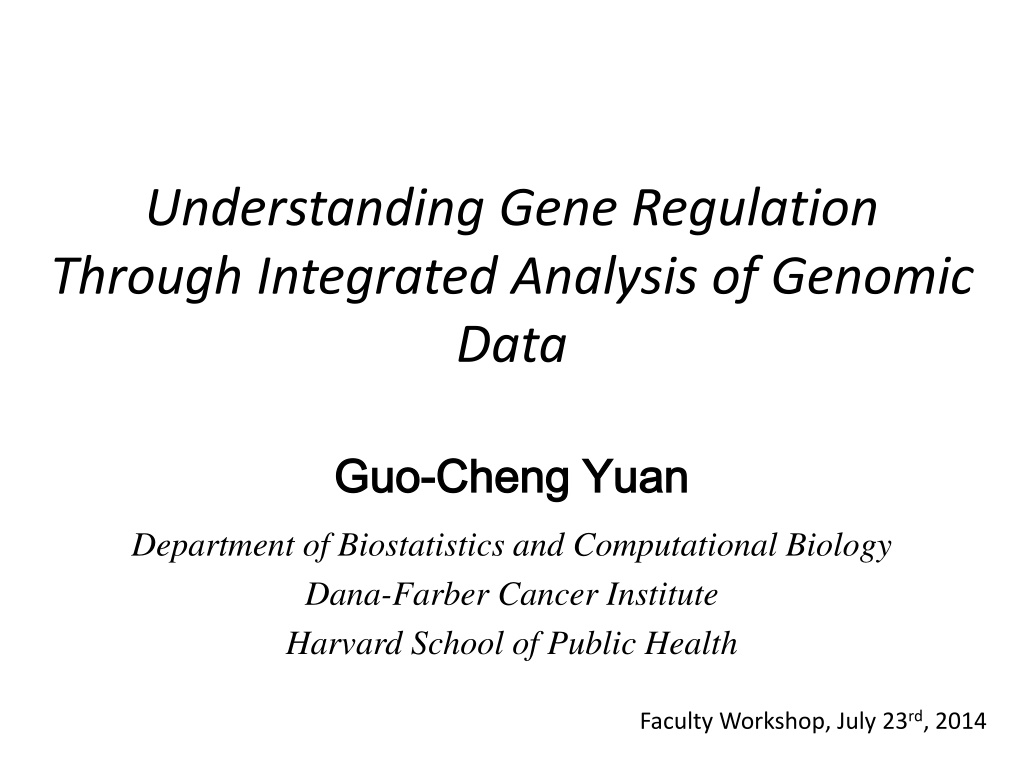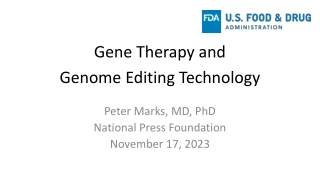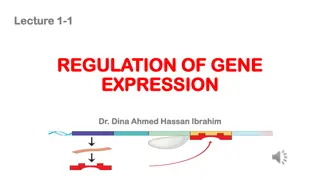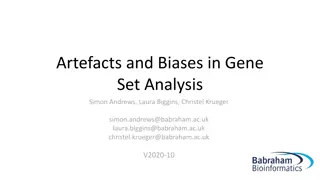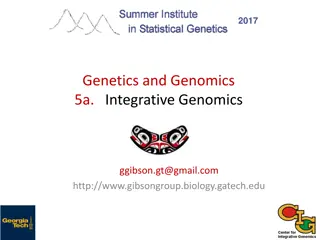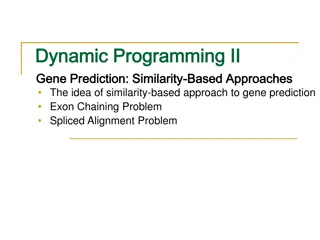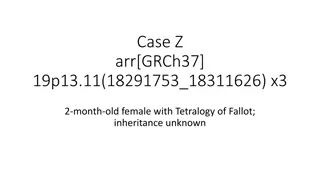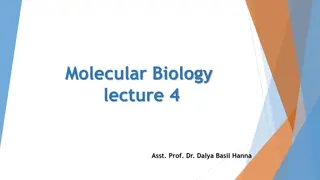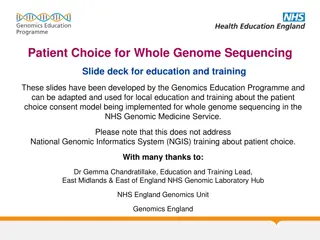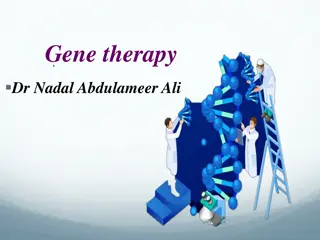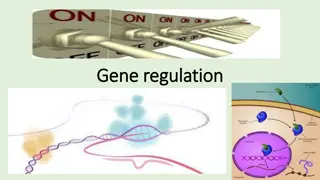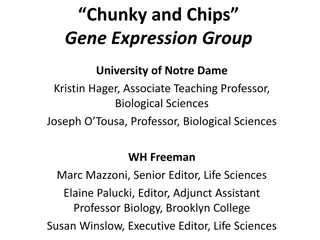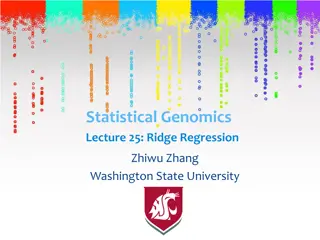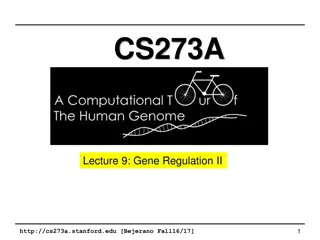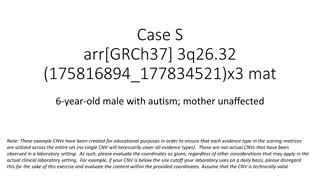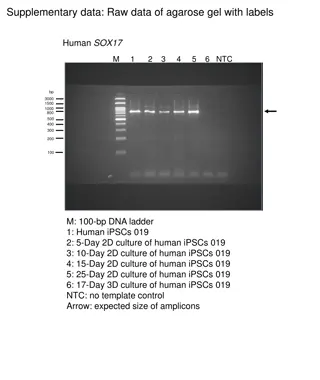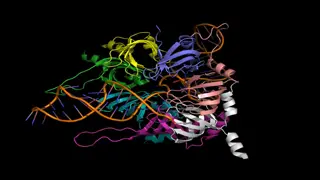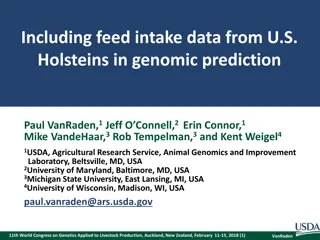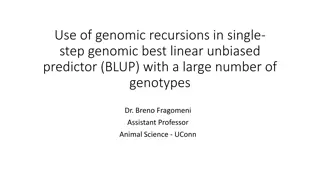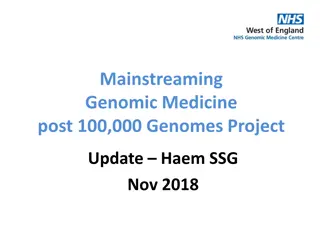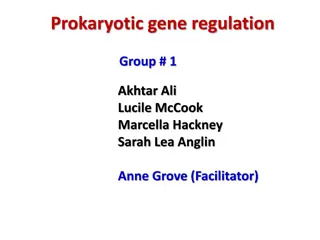Insights into Gene Regulation through Genomic Data Analysis
Explore the intricate world of gene regulation and genomic data analysis through a comprehensive study presented at a faculty workshop in 2014. Delve into the evolution and classification of biology, the impact of genome sequencing on digitizing biology, and the potential of genetic information variations in predicting disease risks. Gain knowledge about the uncharted territories of the human genome and the significant findings by the ENCODE project in unraveling the mysteries of DNA elements and regulatory elements.
Download Presentation

Please find below an Image/Link to download the presentation.
The content on the website is provided AS IS for your information and personal use only. It may not be sold, licensed, or shared on other websites without obtaining consent from the author. Download presentation by click this link. If you encounter any issues during the download, it is possible that the publisher has removed the file from their server.
E N D
Presentation Transcript
Understanding Gene Regulation Through Integrated Analysis of Genomic Data Guo Guo- -Cheng Yuan Cheng Yuan Department of Biostatistics and Computational Biology Dana-Farber Cancer Institute Harvard School of Public Health Faculty Workshop, July 23rd, 2014
Biology used to be about memorizing terms and facts Category Human Zebrafish Domain Eukarya Eukarya Kingdom Animalia Animalia Phylum Chordata Chordata Class Mammalia Actinopterygii Order Primates Cypriniformes Family Hominidae Cyprinidae Genus Homo Danio Species H. Sapiens D. Rerio
Genome sequencing has digitized biology aggcctttgttgttggcagattgctagggtctgaatgtttatgcccctg tgaaatttctttgttgaaatcttcacccctaaggtaatgctattagaagg tgggaaccttagaataattaggtgatggggacagagccctcatgaagggg atcagtgcccttataaaagaaatctgagagagaccctttgccacttctgc catgtgggttagagtgagaagaaggttatttacgagaaagtagcccttac tagacgctgaatcttctggtgccttgatcttagactcaccagctttcaga actgtaagaaataaatttctagtgtttacaagccacccagcctatggtat tttgttatagcatctggaatggactaagacacagaacaagataatgggtg gatatgctaaactttgtatatacacatgtccatttatatttccatatgtc tccatctgttatctatatcaagctaaacatgagttcatattgatgtttcc aattccaattgttacaaaatggatcatcaccttgtttttctgtaatcctc tattcagtgaaaaaccttgctcccatactatgacatccatttatttaatt gttcaatttcattatatatgtacagcaatatccaaattaataacatgtac ccctgtggacatgattatgtgaactagagtatagggcttatAAATTAAAA AAATTTAtttttattttggaaaatgcatataacaaaatgtggcattttaa
Variation of genetic information may predict disease risk wikipedia
Most DNA is not transcribed Most transcripts are noncoding Most proteins has unknown functions Courtesy of National Health Museum
The human genome encodes the blueprint of life, but the function of the vast majority of its nearly three billion bases is unknown. The Encyclopedia of DNA Elements (ENCODE) project has These data enabled us to assign biochemical functions for 80% of the genome, in particular outside of the well-studied protein- coding regions. Many discovered candidate regulatory elements are physically associated with one another and with expressed genes The newly identified elements also show a statistical correspondence to sequence variants linked to human disease, and can thereby guide interpretation of this variation 2007 2012 2012 2012
Quantifying cross cell-type plasticity H3K27me3 variance mean = Score / Plasticity Variance Mean Highly Plastic Regions (HPR): the top 1% with highest plastic score. Lowly Plastic Regions (LPR): the bottom 1% with lowest plastic score.
A pipeline to identify regulatory TFs Pinello, PNAS. 2014 Jan 21;111(3):E344-53
Example: PAX5 in GM12878 1. Motif Enrichment 3. Centralization PAX5 is one of the most enriched motifs in GM12878 specific MPRs Enrichment Score 2. Coordinated Expression (z-score) PAX5 Targeted HPR Genes -2KB MPR_Center 2KB GM12878 PAX5
ChIPseq confirms colocalization between Pax5 and H3K27me3 in GM12878 HPR Center HPR Center -2KB -2KB -2KB -2KB
Haystack is (almost) available! INPUT: Aligned reads from ChIP-seq (.bam files) ONE COMMAND ONLY: haystack_pipeline my_bam_folder hg19 OUTPUTS: Highly plastic regions Tracks normalized for IGV or Genome Browser List of candidate regulatory TFs.
Take home message We shouldn't just focus on a snapshot of the histone patterns and try to interpret what they all mean. Dynamic change is the key to understand biological function.
Conclusions Biology has entered a data-rich era. All models are wrong; but some are useful. ---- George E. P. Box
Acknowledgement Our group Stuart Orkin Luca Pinello Kimberly Glass Eugenio Marco Jialiang Huang Jian Xu Zhen Shao Dan Bauer NIH, Barr Award, Milton Foundation, HSPH CIF
